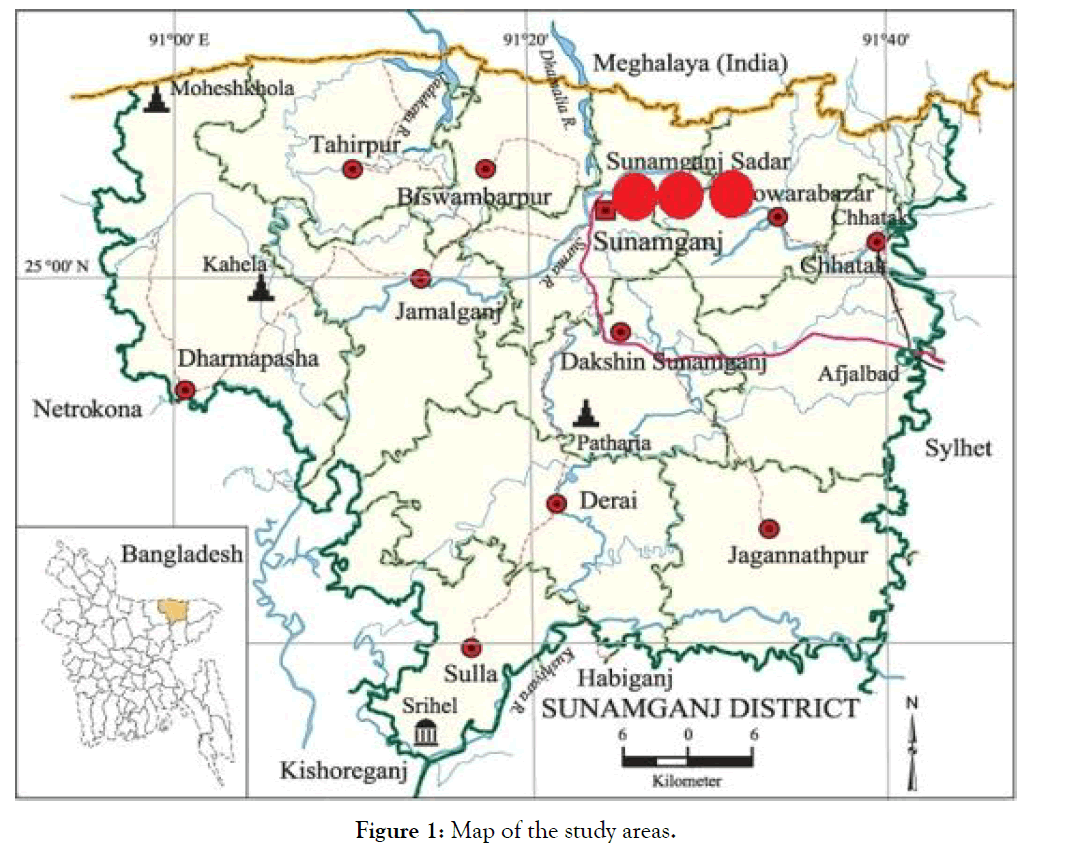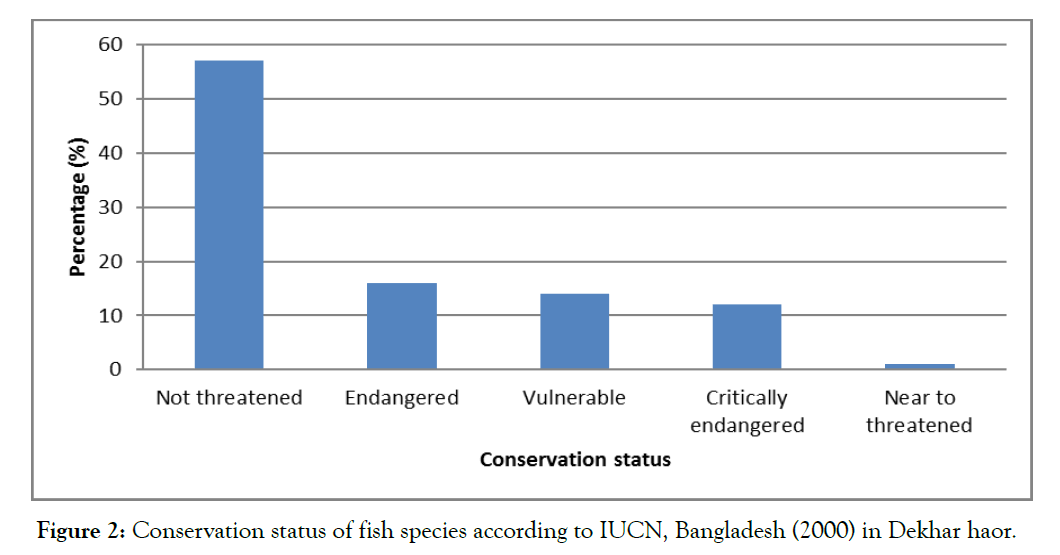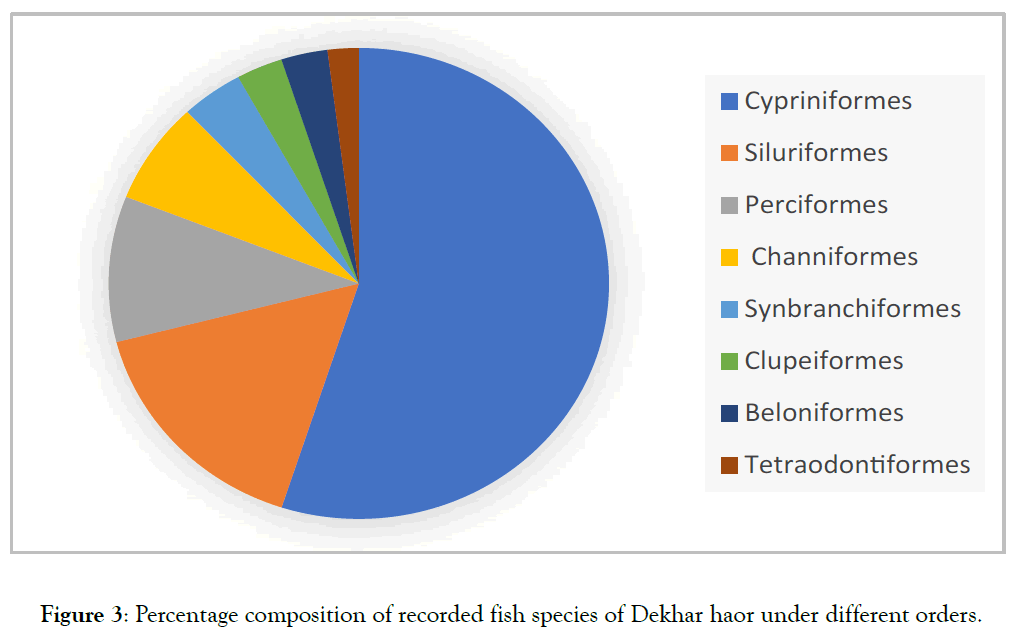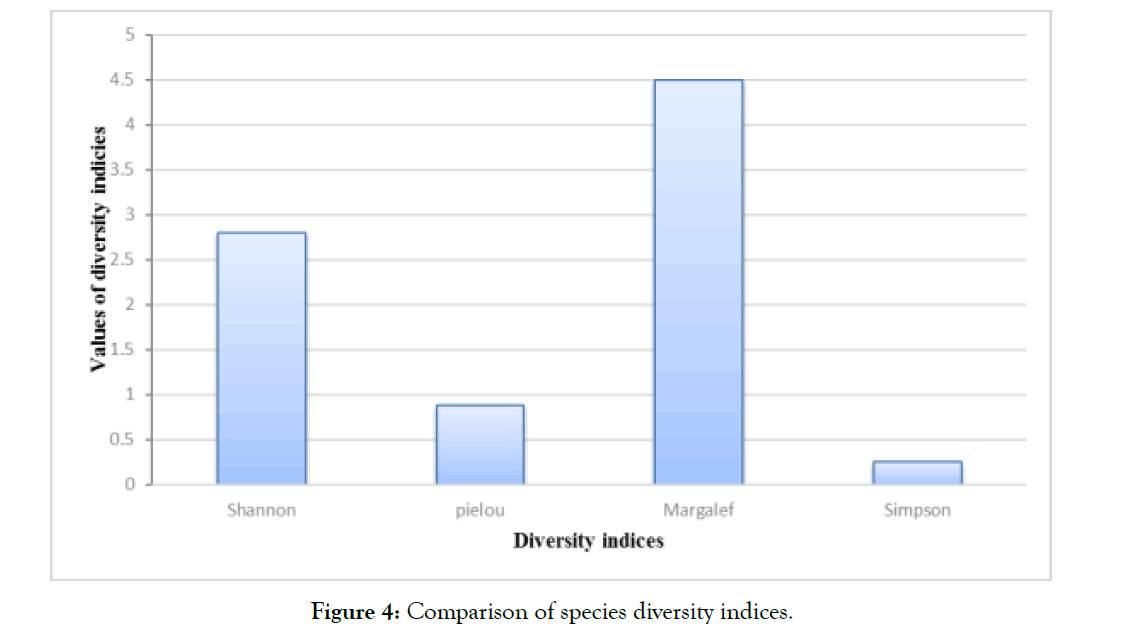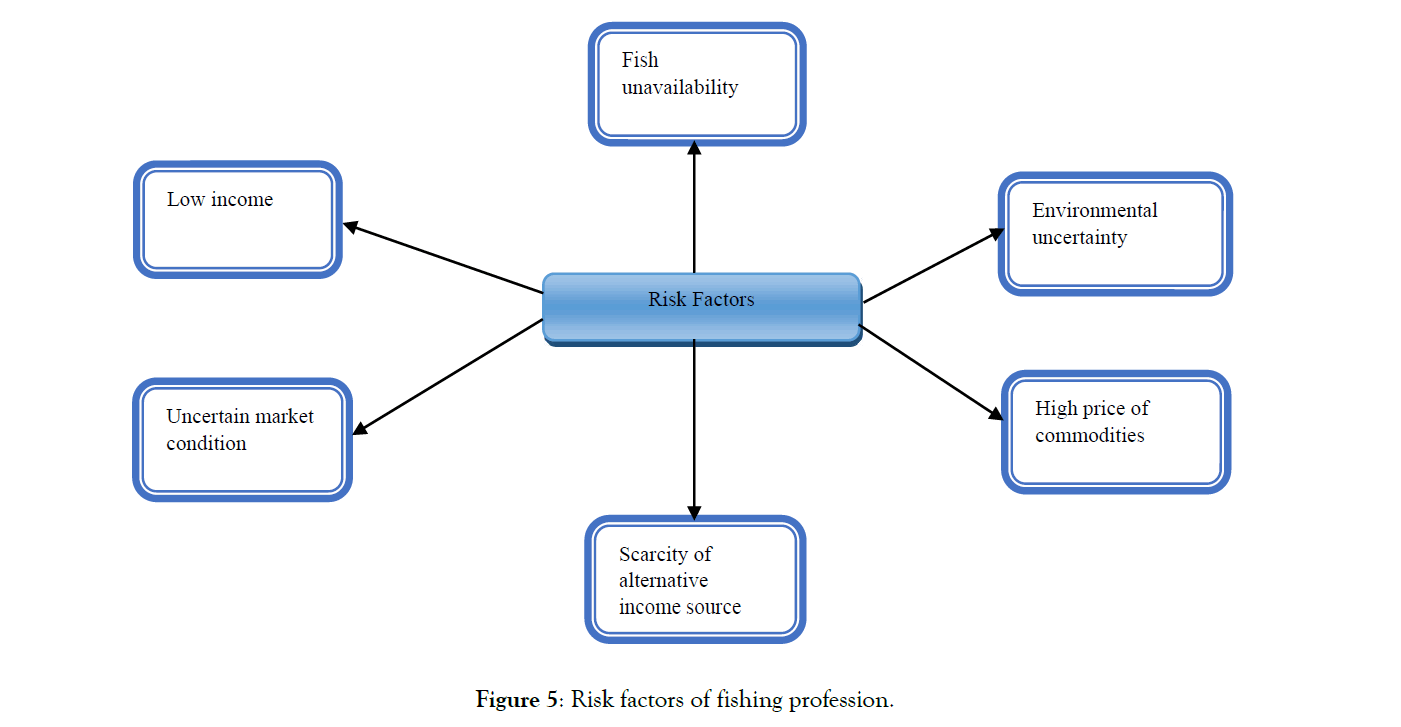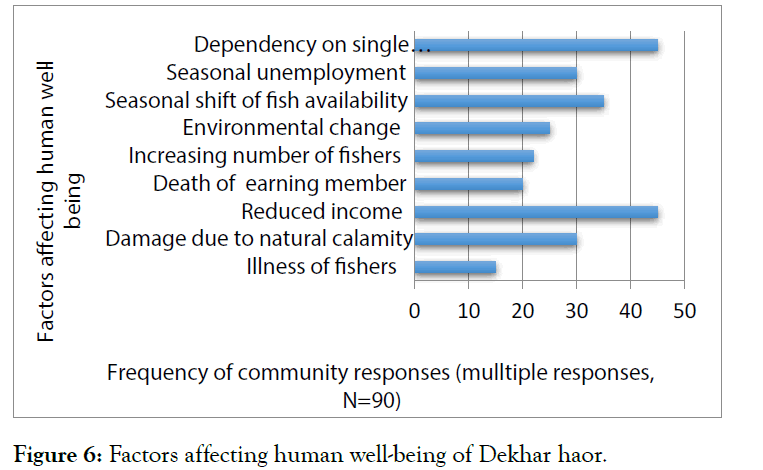Indexed In
- SafetyLit
- RefSeek
- Hamdard University
- EBSCO A-Z
- OCLC- WorldCat
- Publons
Useful Links
Share This Page
Journal Flyer

Open Access Journals
- Agri and Aquaculture
- Biochemistry
- Bioinformatics & Systems Biology
- Business & Management
- Chemistry
- Clinical Sciences
- Engineering
- Food & Nutrition
- General Science
- Genetics & Molecular Biology
- Immunology & Microbiology
- Medical Sciences
- Neuroscience & Psychology
- Nursing & Health Care
- Pharmaceutical Sciences
Research - (2020) Volume 23, Issue 1
Factors Affecting the Biodiversity and Human Well-being of an Ecologically Sensitive Wetland of North Eastern Bangladesh
Atiqur Rahman Sunny1,2*, Rashed Alam3, Masuma Akter Sadia4, Md. Yusuf Miah4, Md. Sabbir Hossain4, Md. Jahid Hossain2, Mst. Sobnom Binta Mofiz4, Sharif Ahmed Sazzad5, Md Ashrafuzzaman1 and Shamsul H. Prodhan12Suchana project, WorldFish Bangladesh and South Asia, Bangladesh
3Department of Aquaculture, Faculty of Fisheries, Bangladesh Agricultural University, Bangladesh
4Department of Aquaculture, Faculty of Graduate Studies, Bangabandhu Sheikh Mujibur Rahman Agricultural University, Bangladesh
5Department of Coastal and Marine Fisheries, Faculty of Fisheries, Sylhet Agricultural University, Sylhet, Bangladesh
Received: 12-Dec-2019 Published: 13-Mar-2020
Abstract
Wetland ecosystem of Bangladesh has great importance for the country’s economic, industrial, ecological, socioeconomic, and cultural aspects. Wetlands of north eastern region are very prominent for freshwater capture fisheries but a few studies focused on comprehensive assessment of biodiversity, conservation necessities, affecting drivers and its impact on natural wetland and dependent community. The present study has been conducted to identify the present status of fish diversity assemblage, dominance index, evenness and distribution of the species, conservation requirements, natural and anthropogenic factors affecting the biodiversity and human well-being of Dekhar Haor by employing qualitative and quantitative methods in two fishing communities. It was noticed that there were 69 fish species under 8 orders where 39 species were not threatened, 11 species were endangered, 10 species were vulnerable, 8 species were critically endangered and 1 species were near to threatened. Cypriniformes (55%) was the most dominant order, followed by Siluriformes (16%), Perciformes (10%), Channiformes (7%), Synbranchiformes (4%), Clupeiformes (3%), Beloniformes (3%) and the rest (2%) belonged to Tetraodontiformes. The present study identified the causes of biodiversity depletion and suggested management measures including establishment of the sanctuary, community-based fisheries management, use of legal fishing gears, proper implementation of fishing laws and regulation. Therefore, the findings of this study could be utilized to plan and execute appropriate natural wetland management strategies.
Keywords
Biodiversity; Livelihood; Wetland; Climate change; BangladeshIntroduction
Bangladesh is situated in the South Asia between 20°34' to 26°38' N latitude and 88°01' to 92°42' E longitude having a national territory of 147570 sq km. The country is blessed with huge inland open water resources [1-3]. These water bodies are reached with fisheries resources and contributed much to make fisheries as an agent of supporting 60% of animal protein demand and accounts for 4.37% of the Gross Domestic Product (GDP) in Bangladesh [4-8]. Bangladesh is enriched with 260 indigenous freshwater fish species with 12 exotic and 24 freshwater prawn species [1,4,5]. North eastern region is very potential for capture fisheries due to the presence of a number of river, canal, beel (static lake) and haor (bowl or saucer shape shallow depression) etc. [1,9] Haor is a diversified aquatic habitat covering about 8000 sq km area of north eastern Bangladesh [1,10,11]. Dekhar haor is an important and ecologically sensitive wetland of Bangladesh, which lies on the Sunamganj Sadar, Dakhin Sunamganj, Chatak and Dawrabazar Upazila of Sunamganj district [1,9]. During monsoon the haor becomes inundated and remains dry for almost six months. Community people of this area cultivate paddy during the dry season in the haor land.
Dekhar haor is known to provide benefits like provision of food, fiber, fuel, flood control, biodiversity conservation, recreation and cultural values. These goods and services support livelihoods of large communities; particularly the poorest of the poor who depend on wetland resources for sustenance [1,5,12-14]. The production and consumption of fish and fisheries resources therefore have important implications for local income and food security [14,15]. This wetland also acts as a breeding, nursing and feeding ground of many local indigenous species but with the passage of the time status of breeding, feeding and nursery ground is not up to the mark due to existing leasing system, lack of monitoring, lack of knowledge of the wetland ecosystem, acute poverty and greedy nature of the local community [1,16-18]. Declining trend of fish biodiversity could be attributed as a vital factor of fishers’ difficulty in obtaining basic livelihood assets. Fishers suffer more due to frequent occurrences of natural calamities, seasonality and others anthropogenic factors. Per capital annual income of the fishers are BDT 2,442 i.e. about 70% lower than the per capital income of the country as a whole [2,19]. As a result, fishing communities are recognized as vulnerable due to deprivation of many amenities [2,20,21]. So, the fishers become reckless and exploit the natural resources particularly available fish biodiversity to maintain their livelihoods [1,2].
Necessity of pragmatic management initiative is very crucial to improve the biodiversity status by maintaining the livelihood sustainability of the dependent communities. To take any management strategy, it is important to know its existing status and trend, but such documents and published works are very limited. Considering the above fact, present study was conducted to identify the existing status of aquatic biodiversity of Dekhar hoar, its trend and threats. This study also assessed how the changing factors affect the delivery of natural services from Dekhar haor and well-being of its dependent population to provide a comprehensive guideline for proper management of this ecologically sensitive wetland.
Materials and Methods
Data collection and sampling
The study has been conducted based on primary and secondary data sources. The primary data on Dekhar haor biodiversity and livelihood information were collected from the local people using structural and semi structural questionnaire around the Dekhar haor villages (24°34´N to 25°12´N, 90°56´E to 91°49´E) named as Thandar gaon, Abadipur and Sunurpur (Figure 1). This study identified the status of fish biodiversity, livelihoods strategies that fishers followed to support their livelihood and possible ways to enhance their capacity to improve their livelihood condition as well as governance and management. 110 individual interviews, 30 Focus Group Discussions (FGD) and 12 key informant interview (KI) were arranged in the Dekhar haor region of north Sunamganj and Sunamganj district. The study was also conducted with the author’s field visit and personal observation for the past few months in the study area.
Figure 1: Map of the study areas.
Fish sampling were conducted simultaneously in the local fishing communities, fishing boats, fish markets and landing centres adjacent to Dekhar haor. Sampling of the fish taxa was conducted on a monthly basis to understand the species composition and diversity of the taxa. Identification of the taxa was fine-tuned by cross-checking with the Catalogue of Life 2017 Annual Checklist Roskov et al. [22] and IUCN Red List of Threatened Species (Version 2017 -1,IUCN 2017) with the IUCN global status and trends of each available taxa [23]. The secondary data were collected from different articles, documents of the Government agencies and NGO reports.
Data analysis
Collected data from questionnaire interviews were entered and analyzed into a database system using the programs: Microsoft Excel (MS Excel 2013). Diversity of the species assemblage was analyzed by the Shannon-Wiener index (H′) [24], species richness was measured by Margalef index (d) [25], evenness was measured by Pielou’s index (J′) [26] and dominance was measured by Simpson index (c) by using following formula:
Shannon-Weiner diversity index (H'):
Where, H' = Shannon Wiener index
Pi = ni/N
ni = No. of individuals of a species
N = Total number of individuals
Margalef species richness (d): d = (S −1) / log (N)
Where,S = Total species
N = Total individuals.
Pielou's evenness index (J'): 
Where,H (s) = The Shannon-Wiener information function.
H (max.) = The theoretical maximum value for H(s) if all species in the sample were equally abundant.
Simpson dominance index (c):
Where, ni = Number of individuals in the ‘each’ species
N = Total number of individuals
S = Total number of species.
Results and Discussion
Dominancy and conservation status of fishery species
This study recorded a total of 69 species in Dekhar haor where 39 species were not threatened, 11 species were endangered, 10 species were vulnerable, 8 species were critically endangered, and 1 species were near to threatened (Table 1). Among 69 species 57% were not threatened, 16% were endangered, 14% were vulnerable, 12% were critically endangered and 1% were near to threatened (Figure 2). Rasbora rasbora, Clupisoma garua, Labeo rohtia, Labeo calbasu, Labeo gonius, Cirrhinus cirrhosus, Cirrhinus reba,,Puntius chola, Puntius sophore, Tetraodon cutcutia, Xenentodon cancila, Rita rita, Channa striatus, Channa punctatus, Chanda nama, Chanda beculis, were dominant species of the haor. The number of available species composition could be more if sampling could be employed consecutive years; nevertheless, the results of a number of studies were more or less convincing with the findings of this study. Very similar findings were reported by Sultana et al. [9] who27 found 71 species in the wetlands of Chatak upazila of north eastern Bangladesh. Sunny et al. [1] found 56 species in the Dekhar haor which was a less than the findings of the present study. Huang et al. [27] found 100 species in Chinese reservoir that was higher than the findings of this study.
Figure 2: Conservation status of fish species according to IUCN, Bangladesh (2000) in Dekhar haor.
| NO. | Local name | Scientific name | Taxa (%) individual | Present status | IUCN | IUCN | ||
|---|---|---|---|---|---|---|---|---|
| Status | global trends | |||||||
| In BD | ||||||||
| Cypriniformes | ||||||||
| 1 | Darkina | Esomusdanricus (Hamilton, 1822) | 3.24 | LA | EN | Stable | ||
| 2 | Darkina | Rasborarasbora (Hamilton, 1822) | 3.5 | LA | EN | Unknown | ||
| 3 | Labuca | Chela labuca (Hamilton, 1822) | 2.7 | R | V | - | ||
| 4 | Titari | Psilorhynchussucatio (Hamilton, 1822) | 1.2 | LA | NT | Stable | ||
| 5 | Sephatia | Bengalaelanga (Hamilton, 1822) | 0.57 | LA | NT | - | ||
| 6 | Joia | Bariliusbendelisis (Hamilton, 1822) | 1.14 | A | NT | Stable | ||
| 7 | Anju | Daniorerio (Hamilton, 1822) | 1.2 | A | NT | Stable | ||
| 8 | Dhela | Osteobramacotio (Hamilton, 1822) | 1.2 | LA | EN | Decreasing | ||
| 9 | Sarpunti | Barbodessarana (Hamilton, 1822) | 0.3 | LA | CE | Unknown | ||
| 10 | Chalapunti | Puntiuschola (Hamilton, 1822) | 3.5 | LA | NT | Unknown | ||
| 11 | Molapunti | Puntius guganio (Hamilton, 1822) | 3.5 | LA | NT | Unknown | ||
| 12 | Kanchanpunti | Puntiusconchonius (Hamilton, 1822) | 3.2 | LA | NT | Unknown | ||
| 13 | Tit punti | Puntiusticto (Hamilton, 1822) | 3.1 | A | V | Unknown | ||
| 14 | Jatpunti | Puntiussophore (Hamilton, 1822) | 3.24 | A | NT | Unknown | ||
| 15 | Teri punti | Puntiusteriov (Hamilton, 1822) | 0.4 | A | NT | Unknown | ||
| 16 | Kosuati | Oreichthyscosuatis (Hamilton, 1822) | 1.2 | A | NT | Unknown | ||
| 17 | Gharpoia | Garragotyla (Gray, 1830) | 1.7 | LA | NT | Unknown | ||
| 18 | Koikra | Schisturacorica (Hamilton, 1822) | 0.43 | A | NT | Unknown | ||
| 19 | Dari | Schisturascaturigina (McClelland, 1839) | 0.45 | A | NT | Unknown | ||
| 20 | Shavonkhokra | Schisturabevani (Gunther, 1868) | 1.3 | A | NT | Unknown | ||
| 21 | Poia | Somileptesgongota (Hamilton, 1822) | 1.32 | A | NT | Unknown | ||
| 22 | Rani | Botiadario (Hamilton, 1822) | 1.7 | LA | EN | Unknown | ||
| 23 | Gutum | Lepidocephalusguntea (Hamilton, 1822) | 0.45 | LA | NT | Stable | ||
| 24 | Garua | Clupisomagarua (Hamilton, 1822) | 3.7 | R | CE | Unknown | ||
| 25 | Rui | Labeorohtia (Hamilton, 1822) | 3.5 | A | NT | Decreasing | ||
| 26 | Catla | Catlacatla (Hamilton, 1822) | 1.8 | A | NT | Decreasing | ||
| 27 | Mrigal | Cirrhinuscirrhosus (Hamilton, 1822) | 2.5 | A | NT | Decreasing | ||
| 28 | Kala Baush | Labeocalbasu (Hamilton, 1822) | 3.5 | A | EN | Unknown | ||
| 29 | Bata | Labeobata (Hamilton, 1822) | 2.67 | R | EN | Unknown | ||
| 30 | Jarua | ChaguniusChaguni (Hamilton, 1822) | 3.33 | A | NT | Unknown | ||
| 31 | angrot/kharas | Labeoangra (Hamilton, 1822) | 2.7 | LA | NT | Stable | ||
| 32 | Ghainna | Labeogonius (Hamilton, 1822) | 1.6 | R | EN | Unknown | ||
| 33 | Nandina | Labeonandina (Hamilton, 1822) | 0.4 | VR | CE | Decreasing | ||
| 34 | Ghoramach | Labeopanguisa (Hamilton, 1822) | 1.6 | VR | CE | Decreasing | ||
| 35 | Bhagna | Cirrhinusreba (Hamilton, 1822) | 3.5 | R | V | Stable | ||
| 36 | Mola | Amblypharyngodonmola (Hamilton, 1822) | 0.3 | A | NT | Stable | ||
| 37 | Debari | Daniodevario (Hamilton, 1822) | 1.4 | LA | NT | - | ||
| 38 | Bhol | Raimosa bola (Hamilton, 1822) | 1.2 | LA | NTT | Unknown | ||
| Siluriformes | ||||||||
| 39 | Magur | Clariasbatracus (Hamilton, 1822) | 2.12 | A | NT | Unknown | ||
| 40 | Boal | Wallagoattu (Linnaeus, 1758) | 1.2 | A | NT | Decreasing | ||
| 41 | Shing | Heteroneustisfossilis (Bloch & Schneider, 1801) | 1.2 | A | NT | Stable | ||
| 42 | Pangus | Pangasiuspangagisus(Hamilton, 1822) | 0.43 | R | CE | Decreasing | ||
| 43 | Kajuli | Ailiacolia (Hamilton, 1822) | 0.57 | A | NT | Decreasing | ||
| 44 | Rita | Rita rita (Hamilton, 1822) | 3.7 | VR | CE | Decreasing | ||
| 45 | Ayre | Sperataaor (Hamilton, 1822) | 3.33 | A | V | Stable | ||
| 46 | GolshaTengra | Mystuscavasius (Hamilton, 1822) | 2.7 | LA | V | Decreasing | ||
| 47 | Tengra | Mystusbleekeri (Day, 1877) | 1.2 | A | NT | Unknown | ||
| 48 | BazariTengra | MystusTengra) (Hamilton, 1822) | 0.3 | A | NT | - | ||
| 49 | Garua | Clupisomagarua(Hamilton, 1822) | 3.3 | VR | CE | Stable | ||
| Tetraodontiformes | ||||||||
| 50 | Potka | Tetraodoncutcutia (Hamilton, 1822) | 3.33 | A | NT | Unknown | ||
| Beloniformes | ||||||||
| 51 | Kakila | Xenentodoncancila (Hamilton, 1822) | 3.3 | A | NT | Unknown | ||
| 52 | Ekthota | Hyporamphuslimbatus (Valenciennes, 1847) | 2.7 | A | NT | Stable | ||
| Channiformes | ||||||||
| 53 | Shol | Channastriatus (Bloch, 1793) | 3.36 | A | NT | - | ||
| 54 | Gajar | Channamarulis (Hamilton, 1822) | 3.4 | LA | EN | Unknown | ||
| 55 | Piplashol | Channabarca (Hamilton, 1822) | 2.7 | VR | CE | Unknown | ||
| 56 | Taki | Channapunctatus) (Bloch, 1793) | 0.57 | A | EN | - | ||
| 57 | Raga/Cheng | Channaorientalis)(Bloch & Schneider, 1801) | 3.3 | A | V | - | ||
| Clupiformes | ||||||||
| 58 | Chital | Chitalachitala (Hamilton, 1822) | 1.75 | VR | EN | Decreasing | ||
| 59 | Foli | Notooterusnotopterus (Pallas, 1769) | 1.4 | R | V | Unknown | ||
| Synbranchiformes | ||||||||
| 60 | Tara baim | Macrognathusaculeatus) (Bloch, 1786) | 2.7 | A | V | - | ||
| 61 | Baim | Mastacembelusarmatus (Lacepede, 1800) | 0.57 | R | EN | Unknown | ||
| 62 | Guchibaim | Mastacembeluspancalus (Hamilton, 1822) | 1.7 | A | V | - | ||
| Perciformes | ||||||||
| 63 | Khalisha | Colisafasciatus (Bloch & Schneider, 1801) | 2.4 | A | NT | - | ||
| 64 | Lalkholisha | Colisalalia (Hamilton, 1822) | 0.37 | A | NT | - | ||
| 65 | Koi | Anabas testudineus (Bloch, 1792) | 1.7 | A | NT | Unknown | ||
| 66 | NamaChanda | Chandanama (Hamilton, 1822) | 3.2 | A | V | Decreasing | ||
| 67 | LalChanda | Chandalala (Hamilton, 1822) | 0.57 | R | NL | Decreasing | ||
| 68 | Chanda | Chandabeculis (Hamilton, 1822) | 2.5 | A | NT | - | ||
| 69 | Bele | Glossogobiusgiuris (Hamilton, 1822) | 1.75 | A | NT | Unknown | ||
| 1IUCN Treathened status categories in Bangladesh (BD) according to (IUCN, 2000),Not threatened (NO), Near threatened (NT), Vulnerable (VU),Endangered (EN), Critically Endangered (CR), 2Global IUCN status of the species and global population trends representing here are according to the IUCN Red List of Threatened Species (IUCN 2017). | ||||||||
Table-1: List of different fish species with local name, scientific name, present status and IUCN remarks
Catch composition of fishery species
It was found that Dekhar haor is being used as breeding, feeding and nursing ground for a number of species. A total of 69 fish and prawn species were recorded. 55% of total catch of this study comprised of cypriniformes, whereas 16% were siluriformes, 10% perciformes, 7% channiformes, 4% synbranchiformes, beloniformes and clupiformes both represented 3% each and rest (2%) belonged to Tetraodontiformes (Figure 3). It can be noted that Sunny et al. [1] recorded 75 species from Tanguar haor and Dekhar haor where 53% included Cypriniformes, followed by siluriformes (15%), Perciformes (14%), Channiformes (7%) and Clupeiformes (4%). A total of 71 fish and prawn species belonging to 11 orders and 25 families were recorded from the wetlands of Chatak by Sultana et al. [9]. Joadder et al. found 52 species of fish from Kumari beel (wetland) in Rajshahi, Bangladesh [17]. Siddiq et al. recorded 58 species from 21 families under 9 orders [16]. Paik and chakraborty noted among all the fish species 44% were cypriniformes followed by channiformes, siluriformes and perciformes [18] which were almost similar with the findings of the present study.
Figure 3: Percentage composition of recorded fish species of Dekhar haor under different orders.
Species diversity status
Shannon-Wiener diversity index (H') is dependent on sample size, species richness and evenness [1,20, 28, 29]. Shannon-Wiener diversity index (H') was found to be 2.8 (Figure 4) where Sunny et al. recorded it to be 3.72 in their study [1]. Pielou's evenness index (J') was recorded as 0.88 (Figure 3). Pielou's evenness index was recorded as 0.708295 in the Bakkhali muddy beach of Cox’s Bazar [30] which was more or less similar with the findings of the present study. The value of Margalef index may fluctuate from actual diversity value to some extent as it is not confound with the evenness and species richness value properly [23]. Margalef richness index (d) was recorded 4.5 while (Figure 4) sunny et. al found it was 4.3 [1] which was almost similar with findings of the present study. Simpson dominance index (c) was found as 0.25 (Figure 3) in the Dekhar haor. Similar result was found by Sunny et al. (0.22) in Dekhar haor [1].
Figure 4: Comparison of species diversity indices.
Threats and stressors of Dekhar Haor
Fish biodiversity of the wetlands are in a sever threat due to overexploitation, environmental degradation and the recent trend of climate change [31-33]. This study identified potential threats that included fluctuation of the duration of rainy season, early summer or early winter, indiscriminate use of herbicide and pesticide during the dry season, overfishing, illegal fishing, fishing by dewatering, irrigation, fry and brood fishing and lack of implementation of natural resource management strategy (Table 2). These findings clearly represented that both natural and anthropogenic drivers were responsible for the decline of wetland biodiversity that supported the finding of Islam et al. 2018 [34] Sunny et al. 2019b [3], Sunny, 2017b [35]. Political influence in natural resource was very dominant in that region. The study found some lease system induced by the local political leaders that interrupt the fishing of general people and allures illegal fishing tendency also.
| Natural factors | Anthropogenic factors |
|---|---|
| Variation in rainfall | Over-exploitation |
| Variation in temperature | Illegal exploitation (Exploitation of juvenile, use of destructive gears, exploitation of prohibited species) |
| Strong wave and current | Pollution (Agricultural pollutants) |
| Strong wind | Change in land usage pattern (fish farming) |
| Sudden flooding | Change in land usage pattern (fish farming) |
| Increase of extreme events | Leasing system |
| Scarcity of pure drinking water | Poor governance and policy implication |
Table 2: Factors affecting the Dekhar haor.
Major risks in fishing profession
In this study (75±4%) respondent ensured that gradually they were losing their hope on fishing profession. They identified some responsible factors for this condition that included declining trend of fish availability, lack of alternative income generating activities, incertitude of the environment, low income, high price of daily commodities and restless market price (Figure 5). They claimed that if such condition lasting for long period then this profession will be under threat and life of the fishing community will become more vulnerable. It was also observed that 45±3% of the respondents thought uncertainty was the principal cause of this risk and 62±4% respondent claimed that low income facilities and high price rate of daily commodities were mainly responsible for pushing them into a vulnerable situation.
Figure 5: Risk factors of fishing profession.
Socio-economic concern
Lifestyle of the resource users of the Dekhar haor was totally different from the other parts of the country. Most of the fishers were landless. Some fishers who had land were very marginal in quantity and not able to fulfil their basic needs. Their houses were earth made, shabby, covered by water or remain dump. Their housing structure and living place made them more vulnerable to the environmental changes. Livelihood of the people of this community directly or indirectly was related with the resources of this wetland. Any up gradation and degradation of the fishery biodiversity put significant impact on well-being of these communities [1,2, 34, 36]. Frequent occurrences of natural calamities hampered the productive assets and infrastructures that induced the community in illegal fishing. This increased exposure to the natural calamities affect the health facility, potable water, poor sewage system and inadequate structural protection. People of this community also become vulnerable due to sudden diseases, floods and drought, seasonal fluctuation of fisheries resources and illegal fishing (Figure 6). Illegal fishing tendency to minimize climatic loss ultimately deteriorated the biodiversity situation. [1, 37, 38].
Figure 6: Factors affecting human well-being of Dekhar haor.
Conclusion
Declining trend of biodiversity is the major concerned issue for most of the wetlands of Bangladesh. Illegal fishing of juvenile, brood fishing and overfishing deteriorates the situation more that ultimately put significant impact to the livelihood of the dependent community. To improve the situation, sustainable wetland management policies should be implemented strictly that could be in the form of Community Based Fisheries Management (CBFM), Co-management, Ecosystem Approach for Fisheries Management (EAFM). Besides the management strategy, establishment of permanent and temporary sanctuary should be emphasized. Alternative income generating activity options depending on the perceptions of the local community should be introduced to reduce the dependency on wetland resources. Stocking of indigenous fry to the natural wetland will also help to improve the status of biodiversity. Finally, extensive and more in-depth biodiversity survey is recommended for the conservation of biodiversity and proper management of the wetland ecosystems of Bangladesh.
REFERENCES
- Sunny AR, Reza J, Anas M, Hassan M, Baten MA, Hasan R, et al. Biodiversity assemblages and conservation necessities of ecologically sensitive natural wetlands of north eastern Bangladesh. Indian Journal of Geo-Marine Sciences. 2020;49(01):135-148.
- Sunny AR, Ahamed GS, Mithun MH, Islam MA, Das B, Rahman A, et al. Livelihood Status of The Hilsa (Tenualosa ilisha) Fishers: The Case of Coastal Fishing Community of The Padma River, Bangladesh. J Coast Zone Manag. 2019; 22(2):469.
- Sunny AR, Islam MM, Rahman M, Miah MY, Mostafiz M, Islam N, et al. Cost effective aquaponics for food security and income of farming households in coastal Bangladesh. The Egyptian Journal of Aquatic Research. 2019;45(1):89-97.
- Compendium on Fish Fortnight. Department of Fisheries, MatshyaBhaban, Park Avenue Ramna, Dhaka, Bangladesh. 2005;109.
- Government of the People’s Republic of Bangladesh, Department of Fisheries, Development project. Dhaka, Bangladesh. 2012.
- Shamsuzzaman MM, Islam MM, Tania NJ, Al-Mamun MA, Barman PP, Xu X. Fisheries resources of Bangladesh: Present status and future direction. Aquaculture and Fisheries. 2017;2(4);145-156.
- Islam MM, Islam N, Sunny AR, Jentoft S, Ullah MH, Sharifuzzaman SM. Fishers perceptions of the performance of hilsa shad (Tenualosa ilisha) sanctuaries in Bangladesh. Ocean & Coastal Management. 2016;130:309-316.
- Sunny AR, Hassan MN, Mahashin M, Nahiduzzaman M. Present status of hilsa shad ( Tenualosa ilisha ) in Bangladesh: A review. Journal of Entomology and Zoology Studies. 2017;5(6):2099-2105.
- Sultana A, Sarker AC, Kunda M, Mazumder SK. Present status and threats to fish diversity of wetlands of Chhatak, Bangladesh. International Journal of Fisheries and Aquatic Studies. 2017;5(5):43-48.
- Ahmed I, Deaton BJ, Sarker R, Virani T. Wetland ownership and management in a common property resource setting: A case study of HakalukiHaor of Bangladesh. Ecological Economics, ScienceDirect. 20081(2);429-436
- Hossain T. Study on biodiversity of fish fauna and socio economic condition of Kolimarhaor, Itna, Kishoreganj. Department of Fisheries Management, BAU, Mymensing. 2007;38.
- Iqbal MM, Nasren S, Mamun MAA, Hossain MM. Fish Assemblage Including Threatened Species in Hakaluki Haor, Sylhet, Bangladesh. Journal of Aquatic Trop. 2015;30(3-4):233-246.
- Nishat A, Hossain B, Roy MK, Karim A. Freshwater wetlands in Bangladesh: issues and approaches for management IUCN Publication.1993;9–22.
- Mohammed EY, Wahab MA. Direct economic incentives for sustainable fisheries management: the case of hilsa conservation in Bangladesh. International Institute for Environment and Development. 2013.
- Mahmud TA. Fish biodiversity and socio-economic conditions of the fishing community in some selected areas of Chalanbeel. Depeartment of Aquaculture, BAU, Mymensingh. 2007;27-53.
- Siddiq MA, Miah MI, Ahmed ZF, Asadujjaman M. Present Status of Fish, Fishers and Fisheries of Dogger Beel in Hajigonj Upazila, Chandpur, Bangladesh. Journal of Aquatic Science. 2013;1 (2):39-45.
- Joadder AMR, Alam MB, Siddique MAB, Naim J. Present status of fish diversity in the Beel Kumari in relation to fish sanctuary and fishing gears. Journal of Fisheries.2016;4(2):390-396.
- Paik TK, Chakraborty SK. Ichthyofauna of east Singhbhum district, Jharkhand, India. J Aqua Biol. 2003;18(2):55-60.
- Khan MI, Islam MM, Kundu GK, Akter MS. Understanding the Livelihood Characteristics of the Migratory and Non-Migratory Fishers of the Padma River, Bangladesh. J Sci Res. 2018;10(3):261-273.
- Islam SN, Gnauck A. Effects of salinity intrusion in mangrove wetlands ecosystems in the Sundarbans: an alternative approach for sustainable management. In: Okruszko T, Jerecka M, Kosinski K (Eds.). Wetlands: Monitoring Modelling and Management. Leiden: Taylor & Francis/Balkema. 2007;315-322 .
- Islam MM, Shamsuzzaman MM, Sunny AR, Islam N. Understanding fishery conflicts in the hilsa sanctuaries of Bangladesh. In: Song AM, Bower SD, Onyango P, Cooke SJ, Chuenpagdee R.(eds.) Inter-sectoral governance of inland fisheries. 2017;18-31.
- Roskov Y, Abucay L, Orrell T, Nicolson D, Flann C, Bailly N, et al. (eds.). Species 2000 & ITIS Catalogue of Life, 2017 Annual Checklist. Naturalis, Leiden, the Netherlands. 2017, ISSN 2405-8858.
- IUCN. The international union for conservation of nature’s red list of threatened species. Version 2017-1.
- Shannon CW, Weaver. The mathematical theory of communications. University of Illinois Press, Urbana, IL. 1949.
- Margalef R. Diversity. In: Sournia A (ed.) Phytoplankton ManualUNESCO, Paris. 1978.
- Pielou EC. The measurement of diversity in different types of biological collection. Journal of Theor Biology. 1966;13:131-144.
- Huang D, Liu J, Hu C. Fish resources in Chinese reservoirs and their utilization. In: De Silva SS (ed.), Reservoir and Culture-Based Fisheries: Biology and Management. ACIAR Proceedings. 2001; 98:16-21.
- Belaluzzaman. Ecology of the intertidal Macrobentic Fauna in Cox’s Bazar coast area, Bangladesh. M. Sc. Thesis. Institute of Marine Science and Fisheries, University of Chittagong, Bangladesh. 1995;199.
- Sunny AR. A review on the effect of global climate change on seaweed and seagrass. International Journal of Fisheries and Aquatic Studies. 2017;5(6):19-22.
- Sunny AR, Islam MM, Nahiduzzaman M, Wahab MA. Coping with climate change impacts: The case of coastal fishing communities in upper Meghna hilsa sanctuary of Bangladesh. In: Babel MS, Haarstrick A, Ribbe L, Shinde V, Dichti N. (eds.). Water Security in Asia: Opportunities and Challenges in the Context of Climate Change. 2018.
- Islam MR, Cansse T, Islam MS, Sunny AR. Climate change and its impacts: The case of coastal fishing communities of the Meghna river in south central Bangladesh. International Journal of Marine and Environmental Sciences 2018;12(10): 368-376.
- Islam MM, Sunny, AR, Hossain MM, Friess D. Drivers of Mangrove Ecosystem Service Change in the Sundarbans of Bangladesh. Singapore Journal of tropical geography. 2018.
- Sunny AR. Impact of oil Spill in the Bangladesh Sundarbans. International Journal of Fisheries and Aquatic Studies. 2017;5(5):365-368.
- Pandit D, Kunda M, Harun-Al-Rashid A, Sufian MA, Mazumder SK. Present Status of Fish Biodiversity in Dekhar Haor, Bangladesh: A Case Study. World Journal of Fish and Marine Sciences, 2015;7(4):278-287.
- Nair NBM, Madhusoodanan NKC, Suryanarayanan H. Seasonal variation and species diversity of fishes in the Neyyar river of the Western Ghats. Tropical Ecology. 1989;30(1):69-74.
- Chandran R, Thangaraj GS, Sivakumar V, Dhas BS, Ramamoorthi K. Ecology of Macrobenthos in the Vellar Estuary. Indian Journal of Marine Science. 1982;11:122-127.
- Islam MM, Islam N, Mostafiz M, Sunny AR, Keus HJ, Karim M, et al. Between livelihood and biodiversity conservation: a model study on gear selectivity for harvesting small indigenous fishes in southern Bangladesh. Zoology and Ecology. 2018;28:86-93.
- Iwasaki S, Razafindrable BHN, Shaw R. Fishery livelihood and adaptation to climate change: a case study of chilika lagoon, India. Mitigation and adaptation strategies for global Change. 2009;14 (4):339-355.
Citation: Sunny AR, Alam R, Sadia AK, Miah Y, Hossain S, Mofiz SB, et al. (2020) Factors Affecting the Biodiversity and Human Wellbeing of an Ecologically Sensitive Wetland of North Eastern Bangladesh. J Coast Zone Manag 23:1.
Copyright: © 2020 Sunny AR, et al. This is an open access article distributed under the terms of the Creative Commons Attribution License, which permits unrestricted use, distribution, and reproduction in any medium, provided the original work is properly cited.

